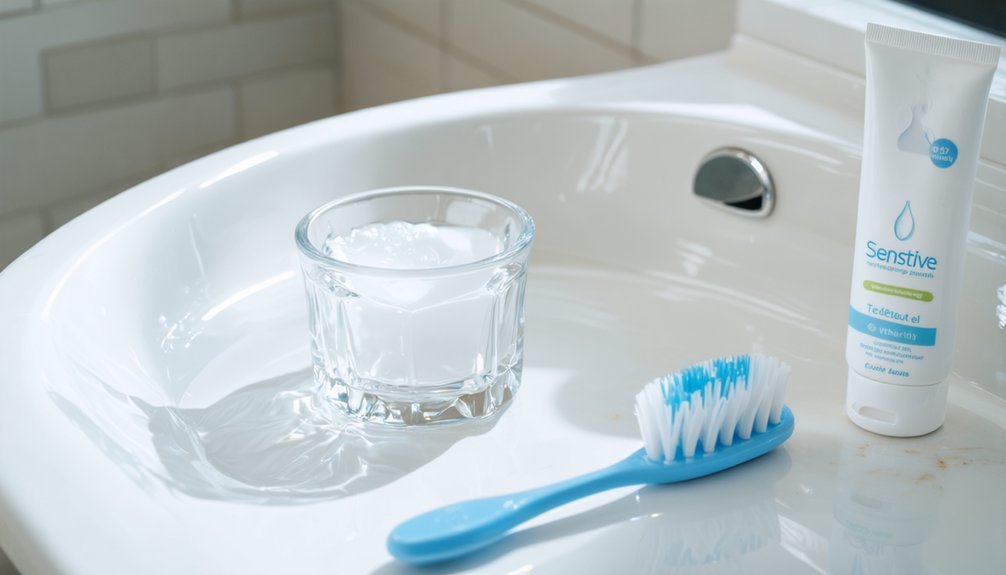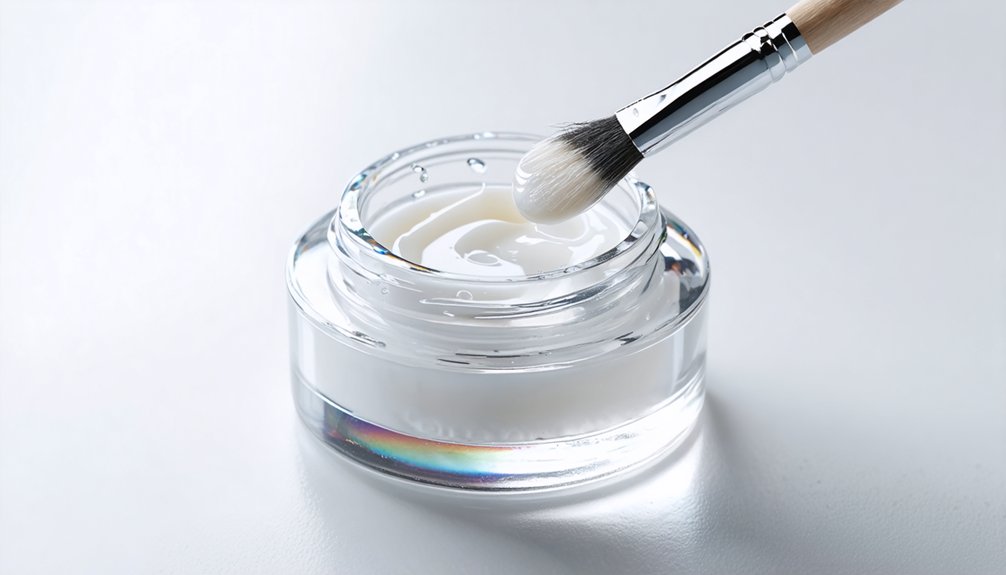Fast-acting whitening gels use hydrogen peroxide or carbamide peroxide to lift stains through oxidation, delivering noticeable results within 1-3 days. You’ll see surface stains begin to fade and teeth lighten 1-2 shades in the first week, progressing to 2-3 shades by week’s end with consistent application. For best results, apply a rice-sized amount (0.5ml) per tooth, wear trays for 30-60 minutes daily, and maintain proper oral hygiene. Understanding the complete treatment protocol guarantees maximum effectiveness and lasting results.
Key Takeaways
- Initial whitening results appear within 1-3 days, showing surface stain removal and teeth becoming 1-2 shades lighter.
- Use hydrogen peroxide or carbamide peroxide gels with 3-20% concentrations for safe, effective at-home whitening treatment.
- Apply a rice-sized amount of gel to each tooth, wear for 30-60 minutes daily, and avoid eating during treatment.
- Expect 2-3 shades improvement after one week and 3-5+ shade improvements by the end of week two.
- Combat sensitivity with desensitizing toothpaste, avoid extreme temperatures, and maintain proper oral hygiene during treatment.
Understanding the Science Behind Fast-Acting Whitening Gels
When you examine the chemistry behind fast-acting whitening gels, you’ll find they rely primarily on two key compounds: hydrogen peroxide (H₂O₂) and carbamide peroxide (CH₆N₂O₃).
These active ingredients work through an oxidation process, where hydrogen peroxide breaks down into water and oxygen molecules that penetrate your tooth enamel and dentin. The nanotechnology developments are showing promise in enhancing this penetration process for more effective stain removal. Over-the-counter products contain 3 to 20 percent concentrations for safe home use.
The peroxide-generated free radicals target stain molecules most effectively in an alkaline environment with a pH of 9.5-10. During this process, complex stain compounds break down into simpler, colorless molecules that reflect more light.
Professional treatments often use concentrated hydrogen peroxide (35%) with light activation to accelerate this reaction, while at-home products use lower concentrations of carbamide peroxide, which releases peroxide more gradually for gentler whitening.
Timeline: What to Expect Day by Day
You’ll notice initial whitening results within the first 1-3 days, with surface stains beginning to lift and teeth becoming 1-2 shades lighter.
During the first week, consistent application leads to more pronounced brightening as the active ingredients penetrate deeper, typically achieving 2-3 shades of improvement. A professional consultation beforehand ensures the treatment will be safe and effective for your specific needs. Since KöR Whitening includes desensitizing agents, most patients can achieve these results without discomfort.
The most significant changes occur by the end of week two, with many users seeing 3-5+ shade improvements, though maintenance treatments are necessary to preserve these results long-term.
First Week Changes
Starting a teeth whitening regimen brings noticeable changes throughout the first week of treatment.
You’ll likely experience initial sensitivity and subtle shade improvements on day one as the peroxide penetrates your enamel.
During days 2-3, you’ll observe increased brightness as the gel breaks down deeper stains, while hydration cycles affect temporary appearance.
Most patients achieve significant brightening effects within the first week of consistent use.
The whitening process requires twice daily applications for optimal results, with treatments in the morning and evening.
Long-Term Results Timeline
Understanding your teeth whitening journey‘s long-term timeline helps set realistic expectations for lasting results. Intrinsic tooth discoloration from age and medications may affect how well treatments work initially.
You’ll find that professional in-office treatments typically provide the longest-lasting effects, maintaining brightness for 12-24 months with proper care. At-home custom trays offer moderate longevity, lasting 6-12 months, while over-the-counter products generally sustain results for 1-3 months.
Several whitening longevity factors influence your results’ duration. Using a strong bleaching agent during in-office procedures produces more dramatic and longer-lasting results compared to at-home options. Professional recommendations emphasize maintaining good oral hygiene, scheduling regular dental cleanings, and avoiding stain-causing substances like coffee and tobacco.
You’ll need periodic touch-ups every 6-12 months to preserve ideal whiteness. Using whitening toothpaste and making dietary adjustments, such as drinking through straws, can greatly extend your results’ lifespan.
For best outcomes, combine different maintenance strategies and follow your dentist’s personalized care plan.
Professional Vs At-Home Treatment Options
When choosing between professional and at-home teeth whitening treatments, several key factors influence the decision-making process.
Professional benefits include higher peroxide concentrations (25-40%) and dramatic results in a single session, while at-home convenience offers flexible scheduling with milder formulations (3-10%). Dental professionals can monitor and adjust treatments to protect sensitive teeth and minimize risks. Dentists carefully apply protective barriers to ensure gum tissue safety during the whitening procedure.
Key differences between these options include:
- Professional treatments deliver up to 8 shade improvements in 1-2 hours under dental supervision.
- At-home kits cost considerably less ($50 vs. $300+) but require weeks of consistent use.
- Professional results typically last longer, often exceeding one year with proper maintenance.
- At-home treatments work best for mild stains and maintenance rather than dramatic transformations.
Your lifestyle, budget, and desired timeline will ultimately determine which option best suits your needs.
Application Steps for Maximum Effectiveness
You’ll need to start by preparing your custom whitening trays, ensuring they’re clean, dry, and fitting properly before applying the recommended amount of gel.
Following the daily application process requires precise gel placement, adherence to specific wear times based on concentration, and thorough post-treatment cleaning of both teeth and trays.
Monitor your progress by tracking treatment duration and watching for sensitivity while maintaining consistent timing between sessions to achieve ideal results.
Prep Your Custom Trays
The proper preparation of custom whitening trays forms the foundation for successful teeth whitening treatment. Before starting gel application, you’ll need to verify your trays are ideally conditioned and fitted for maximum effectiveness.
- Clean your trays thoroughly with cool soapy water and dry them completely, as moisture can reduce whitening efficiency.
- Inspect the tray edges to confirm proper scalloping on the facial side and straight trimming on lingual edges below gingival margins.
- Test-fit the trays without gel to verify comfort and make any necessary adjustments to prevent soft tissue contact.
- Brush and floss your teeth thoroughly before tray preparation to enhance the whitening gel’s performance.
Once your trays are properly prepped, you’re ready to begin the precise application of whitening gel for ideal results.
Daily Application Process
Proper application of whitening gel requires meticulous attention to detail for ideal results and minimal sensitivity.
For your daily routine, start by thoroughly brushing and flossing your teeth, then dry them completely with a tissue. Apply a rice-sized amount (0.5ml) of gel to each tooth compartment in your custom trays, placing it halfway up the inner front surface.
Secure the trays firmly against your teeth, ensuring close contact. If any gel seeps onto your gums, wipe it away immediately with a cotton swab.
Follow the specified wear time based on your gel’s concentration, typically 30-60 minutes. Don’t eat, drink, or talk excessively during treatment.
After removing trays, rinse with lukewarm water and gently brush your teeth. These application tips help maximize whitening effectiveness while minimizing sensitivity.
Monitor Progress and Timing
Successful teeth whitening requires careful monitoring of your progress and precise timing of applications to achieve ideal results. Implement systematic progress tracking by taking baseline photos and documenting weekly changes in tooth shade.
You’ll need to adjust your treatment strategy based on visible results and sensitivity levels.
- Document each application session’s timing and duration to maintain consistency in your whitening routine.
- Take weekly progress photos to compare against your baseline image, using consistent lighting conditions.
- Monitor any tooth sensitivity or gum irritation, reducing application time if discomfort occurs.
- Use shade guides or specialized apps to objectively measure whitening progress over time.
If you don’t see improvements after two weeks, you may need to adjust your approach through longer application times or consulting a dental professional for stronger options.
Tips to Maintain Your Brighter Smile
Maintaining your newly whitened smile requires a multi-faceted approach that combines diligent oral hygiene, smart dietary choices, and regular professional care.
For effective whitening maintenance, brush twice daily with a gentle whitening toothpaste and floss regularly to prevent stain-causing plaque buildup. You’ll need to modify your dietary habits by limiting exposure to staining substances like coffee, tea, and red wine. When you do consume these beverages, use a straw to minimize contact with your teeth.
Schedule professional cleanings every six months and discuss touch-up treatments with your dentist. After whitening, avoid staining substances for at least 48 hours while your enamel is most vulnerable.
Replace your toothbrush every three months and consider using dentist-recommended whitening products for ongoing care.
Managing Sensitivity During Treatment

While maintaining a bright smile is important, tooth sensitivity during whitening treatments can be a significant concern for many patients. Effective sensitivity management and discomfort prevention are essential for a comfortable whitening experience.
You’ll need to take specific steps during your treatment to minimize potential discomfort.
- Use desensitizing toothpaste containing potassium nitrate or fluoride to block nerve signals and reduce sensitivity
- Brush gently with a soft-bristled toothbrush and lukewarm water to avoid triggering pain responses
- Take over-the-counter pain medication if needed to manage inflammation and discomfort
- Avoid extreme temperatures and acidic foods immediately after treatment, using a straw when drinking
Remember to maintain consistent communication with your dental professional throughout the process, as they can adjust your treatment protocol based on your sensitivity levels.
Best Practices for Long-Lasting Results
To achieve lasting whitening results, you’ll need to implement a thorough strategy that encompasses proper preparation, application technique, and post-treatment maintenance.
Start by thoroughly cleaning your teeth before applying whitening gel, using gentle circular motions with a soft-bristle toothbrush to remove plaque that could interfere with the treatment.
Apply the gel precisely, using a rice grain-sized amount per tooth compartment in your custom trays, and wipe away any excess that contacts your gums.
After treatment, maintain proper oral hygiene by brushing twice daily and avoiding stain-causing substances.
Consider using maintenance gels every 3-6 months, and drink dark beverages through a straw to minimize contact with your teeth.
Schedule regular dental cleanings to remove surface stains and preserve your whitening results.
Frequently Asked Questions
Can I Whiten Teeth With Existing Crowns or Veneers?
You can’t whiten crowns or veneers as they’re resistant to bleaching agents. Crown whitening and veneer care require different approaches, as only your natural teeth respond to whitening treatments.
Is It Safe to Use Whitening Gel While Pregnant or Breastfeeding?
You shouldn’t use whitening gels during pregnancy or breastfeeding due to whitening safety concerns and insufficient research. Wait until after delivery and consult your dentist for ADA-approved alternatives like whitening toothpaste.
How Long After a Dental Cleaning Should I Wait Before Whitening?
While some wait weeks, you can actually start whitening immediately after your dental cleaning for ideal results. Your teeth’s pristine state post-cleaning creates perfect conditions for even, effective whitening treatment.
Can Teenagers Use Fast-Acting Whitening Gels?
You shouldn’t use fast-acting whitening gels until you’re at least 14 and all permanent teeth have emerged. For teenage dental health, consult your dentist first and follow safe whitening practices under professional supervision.
Will Whitening Gel Affect the Strength of Dental Bonding or Fillings?
Yes, whitening gel will temporarily reduce the strength of bonding materials. You’ll need to wait 1-3 weeks after whitening to guarantee ideal bonding effectiveness for any dental work you’re planning.
References
- https://www.pearldentalsc.com/how-long-kor-whitening-takes-to-show-results/
- https://drkevindds.com/how-long-does-teeth-whitening-take/
- https://whitehorsedental.com.au/home-teeth-whitening-results/
- https://www.healthline.com/health/how-long-does-teeth-whitening-last
- https://www.trysnow.com/blogs/news/how-to-use-teeth-whitening-pen
- https://www.nspali.com/how-long-does-teeth-whitening-last/
- https://www.coppertopdental.com/blog/what-timeline-can-you-expect-for-teeth-whitening
- https://www.ada.org/resources/ada-library/oral-health-topics/whitening
- https://sandlakedental.com/blog/understanding-the-science-behind-teeth-whitening/
- https://www.417dentist.com/teeth-whitening-gel-science-effectiveness/



